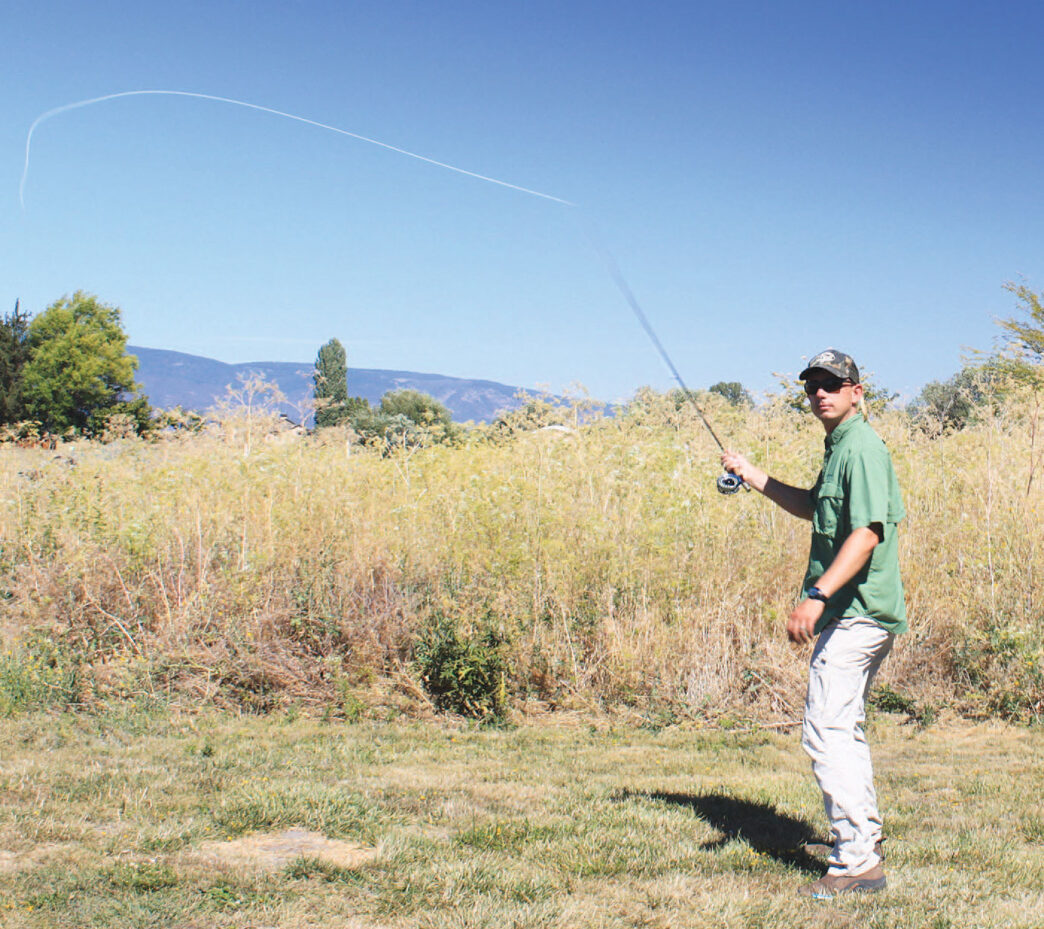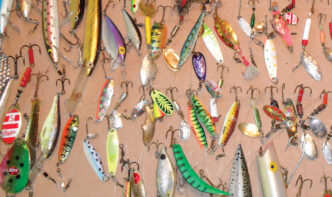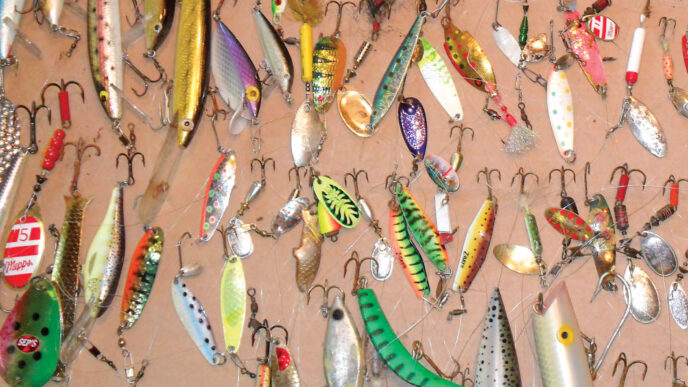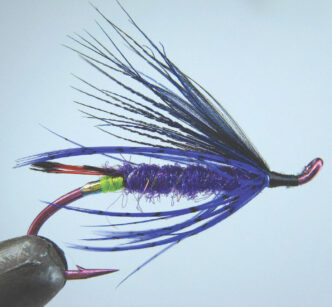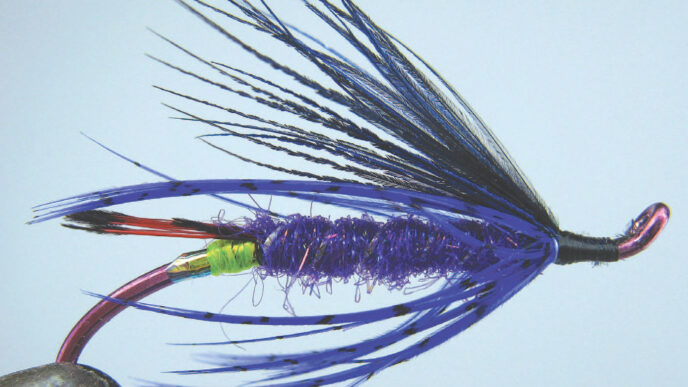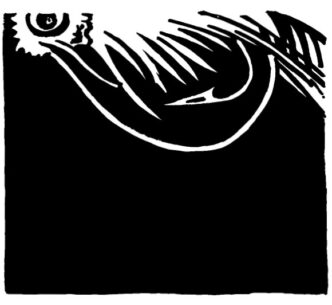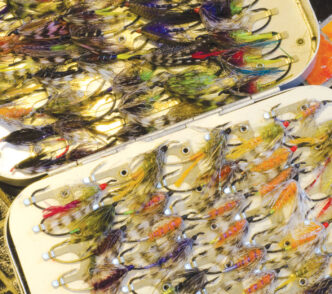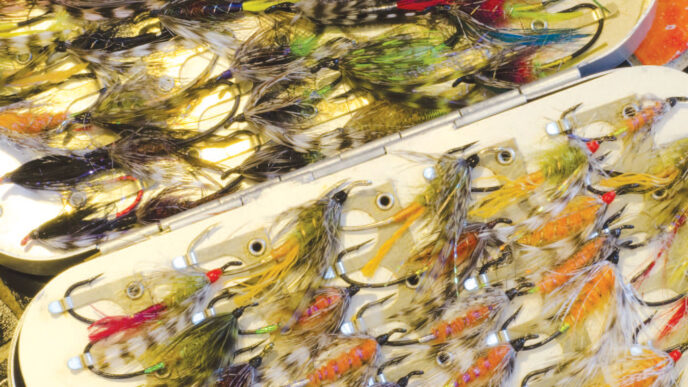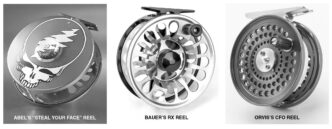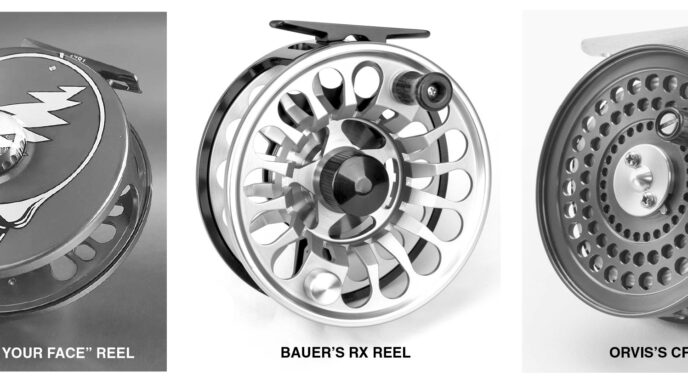As a seasoned fly-fishing guide, I’ve witnessed the entire spectrum of fly casting, from the triumphs to the miserable failures. One of the most frustrating experiences for clients is when they are presented with a relatively straightforward casting situation and they just can’t get it done. Maybe it’s a 40-foot cast that has to go over your off shoulder, a 30-foot cast that has to fly over your buddy’s head without hooking him, or even a 20-foot cast that needs to land with the leader straight. You’ve made that cast before, but you’re just a little too rusty to pull it off.
Sound familiar? Read on for several helpful observations and recommendations. They address common casting problems, issues with casting from boats, and a bit of fly-line theory. At the end, you will find a simple checklist to run through on the lawn prior to your next fishing trip. These drills will help improve your casts without changing any of the mechanics of your casting stroke.
Sideways Casting
One of the most common and easily corrected casting problems occurs when people do not face their body in the direction in which their cast is going. To visualize this phenomenon, imagine someone facing north and needing to make a cast in that direction. But when they do, their cast, if made with the right arm, for example, heads left, to the northwest. To compensate for this phenomenon, they must face northeast to cast north. This condition is caused by human nature, chiefly our ball-throwing intuition. We’re used to throwing things, and to throw something far, you have to drop your dominant foot back. That opens up your stance, allowing you to transfer your weight from your back foot to your front foot, assisting the throw. But every movement of your body is transferred to the fly rod and amplified greatly nine feet away, at the rod tip. Since the line follows the rod tip, any extra motion that deviates from a straight-line trajectory can cause the cast to veer away from the target. When you drop that dominant foot back, it’s very difficult to avoid rotating your upper body when you make the cast — in this case, rotating it from northeast to due north. When you rotate your upper body, the rod tip goes along for the ride and deviates substantially from the desired straight-line trajectory — here, throwing the cast to the left. The transfer of weight from back foot to front foot also leads to a lot of fancy footwork that can get the line stuck under our feet. The fix for sideways casting is easy.
Get that dominant foot a little forward of your other foot so your torso is square to the direction that you want to cast. Make sure your belly button and nose stay pointed at your target throughout the entire casting stroke. Once you fix your stance, it’s not hard to break the inclination to cast sideways.

Don’t Rock the Boat
Boats are a great platform for fly fishing. They allow an angler to sneak up on fish that can’t be reached from shore. One sure way to spoil this advantage is to alert the fish to your presence by rocking the boat and creating waves. In many fishing situations, rocking the boat will cause nearby fish to stop feeding and flee in terror. In guided fishing situations, rocking the boat is also guaranteed to drive your guide crazy.
Many boat-bound anglers, especially those who are a bit rusty (you know who you are), find it very difficult to cast without rocking the boat, sometimes severely. To be a good caster, you must master the ability to cast with your arm and not your body. It is crucial to isolate the moving parts in your shoulder, arm, and wrist from the rest of your body. For anything short of a tournament-winning distance cast, it is not necessary to shift your weight around when you cast.

If you are a boat rocker, there is an easy drill that will help improve your casting ability in short order. Take a chair without armrests out to the lawn and have a seat. Try to cast 20 to 30 feet of line while sitting. If you find it difficult to cast from the seated position, you are probably accustomed to leaning back and forth while casting, and that’s what rocks a boat.
Casting from the seated position is a great exercise for many reasons. It forces you to focus on technique, because it does not allow you to throw your weight around. It also makes you keep your loop airborne while closer to the ground. And it prepares you for situations in which it’s advantageous to stay seated in a boat while you fish. The have-a-seat drill will also help with the next two boat-related casting issues.
Back-Seat Tangler
I do a lot of guiding from a drift boat. Most drift boats are laid out so that the oarsman is in the middle, with one angler in the front (bow) and another angler in the back (stern). Most of my clients jockey for position, trying to secure the position in the bow. While there is an obvious advantage to being in the front, because you get the first shot at the fish, many anglers also try to avoid the back seat because they have trouble casting there. Never fear, there are some easy fixes that make casting from the back of the boat a breeze.
One of the casting issues in the back of the boat is that for some people, the extra fly line between the reel and the stripping guide manages to wrap around the back seat on almost every cast, every time you let go of the line with your line hand to let it shoot out. You might try folding the back of the seat down, but that’s usually to no avail. This experience is absolutely maddening, but easily fixed. I’ve watched lots of people cast from the back of the boat, and it’s very clear why some people wrap their line around the seat and others don’t. The people who wrap their line around the seat rotate their whole upper body when they cast, and the non-tanglers refrain from rotating the upper body.

Is it necessary to rotate your torso when you cast? No. But again, it is human nature. We like to throw our weight around when we throw things. We like to turn our bodies to see where the back cast goes. The easy fix is to plant your feet firmly on the deck and to cast with your arm only. Even if you’re water loading a big indicator with split shot and three flies, this feat can be easily managed without rotating your upper body. Remember, you spent a lot of money for your fly rod. Try to get your money’s worth by making the rod do the casting. Give your upper body a break. The other maddening element in fishing from the back of a drift boat is that there is no place to put your excess fly line. It has to go on the deck, where it is easily stepped on. There is nothing worse than making an urgent cast that doesn’t reach its destination because the line gets trapped under your foot. While this problem is not totally avoidable, the people who suffer the most are — yes — the full body casters. People who cannot confine their casting stroke to their arm tend to rock back and forth when they cast. People who rock usually do a lot of fancy footwork in the boat. Every time you move your feet, there is an excellent chance that you will step on your fly line. If you fit the description of a full-body caster, try the chair drill mentioned earlier. If you eliminate the footwork, you eliminate 90 percent of the tangles caused by stepping on your line.
Footwear for Boat Fishing
Selecting appropriate footwear for your next boat trip will help improve your casting experience greatly. The worst shoes for boat fly fishing are water shoes or sandals with lots of buckles, Velcro straps, or drawstrings. Tennis shoes are good, although the line will occasionally get caught in the laces. Shoes without any protrusions on top are great. As for the bottom of the shoe, the smoother, the better. Hiking boots and water shoes with gnarly rubber tread tend to grab the line and hang on.
Overlining Rods
A time-honored tradition in many angling circles is to overline the fly rod. That simply means matching a 6-weight line with a 5-weight rod, for example. This practice was very common years ago, before the weight and feel of fly rods became highly standardized. Now that the line weights are standardized, it’s the first 30 feet of the fly line (from the leader end, not the reel end) that matter when assigning a line a number. For example, a 5-weight fly rod is designed to be well matched to a 5-weight fly line when casting 30 feet of fly line. At that distance, the line should load the rod easily, but not too much. Shooting line and false casting should feel great.
It follows that at a much shorter distance, say 15 feet, the properly matched line won’t load the rod quite as well. It is for this reason that some people still recommend overlining fly rods. After all, most casts, especially when trout fishing, are under 30 feet. There are many days when you never get more than 15 feet of line out. If this describes your fishing style, then it won’t hurt to overline your rod.
However, there are some factors you should consider. First, what happens when you do need to throw a long cast? On a 60-foot cast, your one-size-heavier fly line is going to be difficult to cast. It will tend to “squash” the rod, meaning that it’s just a little too much weight for the rod to cast well. It will also tend to land hard on the water. A 6-weight line is quite a bit heavier than a 5-weight line. If you are in need of a delicate presentation, your one-size-heavier line is not going to do you any favors. It will tend to land like a ton of bricks on the water, especially on a longer cast. If delicate presentation or long casts are in your future, you should think twice before overlining your fly rod.

Furthermore, in an effort to make it easier for beginners to cast with ease, the fly-line manufacturers have already added extra weight to some of their fly lines. Some of the new (and highly popular) specialty tapers are already overlined by a half or full-line weight. Instead of a 5-weight, you are really casting a 5-1/2 or 6-weight line. Because it’s already overlined a little bit, the line loads more easily on those short casts. However, these lines are not going to be the best choice if you plan on making a lot of long casts or making a lot of delicate presentations.
False Casting
The false cast is oft-maligned. After all, are the fish in the air, or in the water? Haven’t we all heckled a far-off angler who throws about 30 false casts before landing his fly? Most of us have been trained to keep our false casting to a minimum, which is a good idea. Some anglers have taken it a step further and are under the impression that they can dispense with false casting altogether.
That’s great if you’re nymphing. False casting should absolutely be avoided, if possible, when nymphing. With an indicator, a fly or two, plus weight on the line, any extra motion should be eliminated. Each false cast is another opportunity for all of those moving parts to tangle up. But when the fish are rising and it’s time to fish dries, false casting is essential. As a guide, I get a a number of clients who prefer to fish dry flies, but can’t actually remember how to do it when they get the chance. Often, the memory block has to do with insufficient false casting.
There are many good reasons to false cast. It helps dry out the fly, shoot line, change the direction of the cast, and gauge the distance of the cast. When you are in a situation that requires accuracy and delicate presentation, false casting is essential. If you don’t throw a false cast, you really have no chance of making the fly go where you want it to go. It may take four or five false casts to present your fly accurately.
However, avoid throwing your final cast in a different direction than all of your false casts. Many anglers do this so that the water that flies off the fly line while false casting does not land near their target. That’s a great idea, because it helps keep you from spooking fish, but make sure you make at least one false cast after the change in direction. It’s not realistic to expect your fly to land accurately if you change direction on your final cast. Instead, don’t try to make any huge change on any single cast, especially on your last cast. Make small changes in your distance and aim on each cast, then lay your fly down without doing anything drastically different on your final cast. If you try to shoot more than three feet of line on your final cast, there is a great likelihood that your fly will land too far away from your target or too short.
Don’t get carried away with the false casts, but do enough to achieve a good presentation. In trout fishing, there is rarely a huge rush when accuracy is required. If you are waiting for a fish that is only rising occasionally, it is often necessary to wait a minute or more before making your next presentation. Do not fill that patient waiting time with pointless false casting. Each extraneous false cast can potentially frighten the wary fish you are pursuing and keep it from rising in the first place.
A Checklist
Prior to your next fishing trip, find an open grassy area and run through this casting checklist. These drills should significantly improve your casting. Please note that you should always have a leader on your fly line while practicing casting. Since the leader will get trashed in the process, use an old one.
- On the lawn, have a seat on a bench or a chair with no armrests. Cast 20 to 30 feet of line and lay it out straight. Get used to casting from the seated position. Isolating your arm and preventing your body from rocking will dramatically help your casting stroke. If you find it difficult to cast while seated, practice makes perfect. Keep at it.
- Stand up and cast 20 feet of line and lay it out straight. Make sure your belly button is pointed at your target. As you cast, your nose and belly button should be pointed at your target throughout the entire casting stroke. If they aren’t, check your stance. Your dominant foot should be at least as far forward as your other foot. When you drop your dominant foot back, it’s likely that your upper body will rotate throughout the casting stroke, causing all sorts of problems.
Now strip out 40 feet of line. Practice shooting line. Start with casting just 5 feet of fly line. Shoot a little bit of line out on each cast, taking at least five false casts to get out the entire 40 feet of line. Make sure that the pace of the cast is fast when you have almost no fly line out and that the pace slows as you introduce more and more line. The power level should also change as you introduce line. Make sure that your short casts are performed with very little force and that you gradually apply more power as you introduce more line. Try to see how much you can dial back the power level and still throw a good cast. Avoid casting your 10-foot cast with the same amount of energy as your 40-foot cast. - Practice false casting. Start with 20 feet of line. Make three false casts and then lay the line down, as if you were presenting your fly. Try to make the false casts identical. The last one should be different only in that you allow the line to unfurl and land on the lawn. This drill will help with your accuracy and your ability to unfurl your fly line and leader in a straight line.




